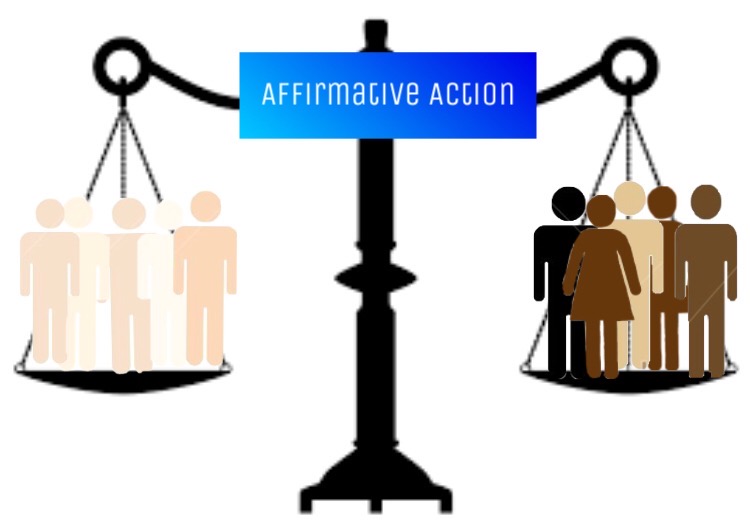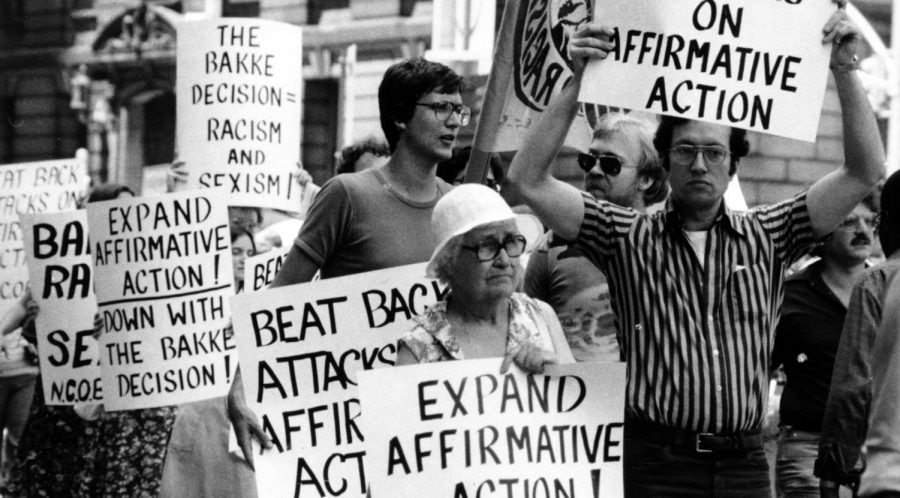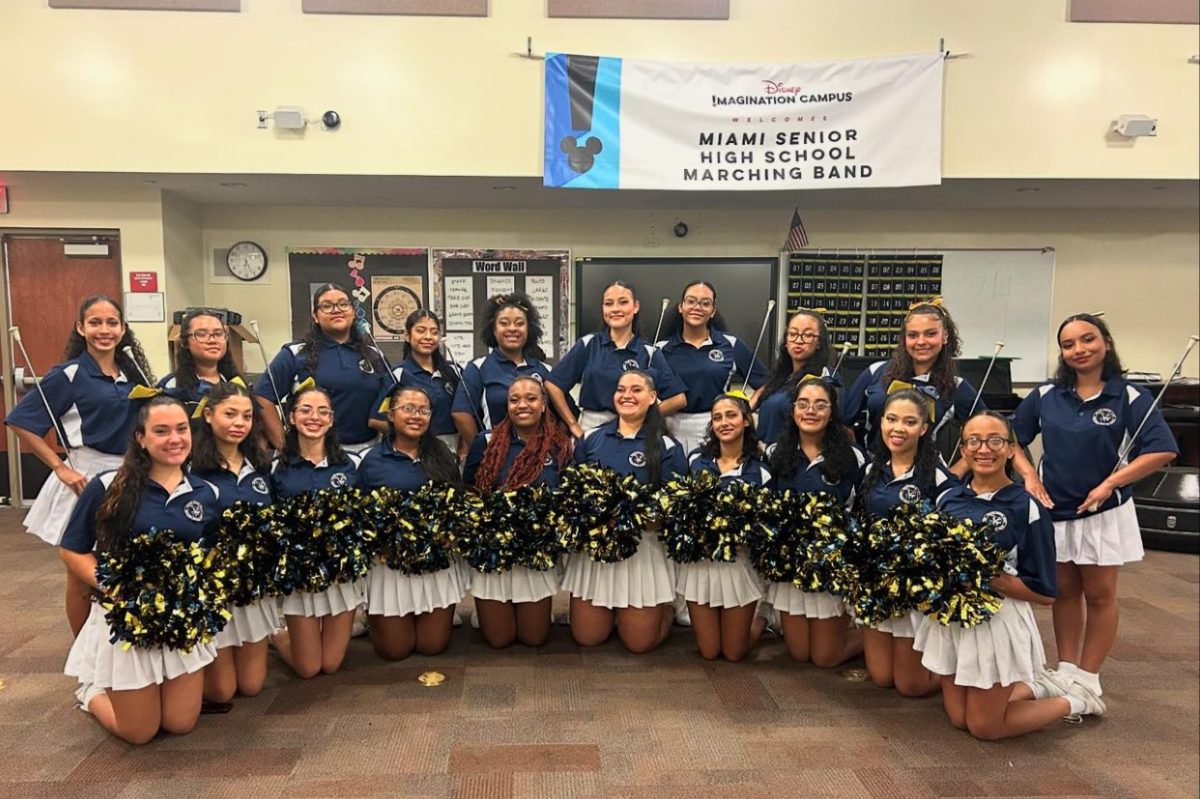White Privilege and Affirmative Action: The Impact on College Admissions
A protest at the U.S. Supreme Court during the University of California v. Bakke (1978) case. (Source: https://www.urban.org/urban-wire/40-years-after-bakke-decision-whats-future-affirmative-action-college-admissions)
February 23, 2021
There have been multiple scandals where universities are being called out for causing disadvantages to minorities. According to the Washington Post, a 2019 lawsuit was filed against Harvard University for intentionally discriminating against Asian applicants. In November 2020, the court ruled in favor of Harvard University; however, this ruling raised a question of “How long should universities be able to consider race?”
We can’t deny that a student’s race and ethnicity play a role in the college admission process. But how much does a student’s demographic impact college admissions and acceptance? With the disparities in school demographics, it’s important to understand the two factors that may have an impact on the college admission process: white privilege and affirmative action.
Racial Discrimination in College Admissions
Racial discrimination has been a prominent issue in America. There were multiple scenarios where minorities were denied college admission due to their race and ethnicity. According to the National Museum of African American History and Culture, in 1952, Autherine Lucy and Pollie Anne Myers were denied admissions after submitting applications that indicated their race. It took legal effort- Lucy and Myers vs. University of Alabama- and three years for Lucy to walk through the halls of a predominantly white school; however, she still faced discrimination and harassment from her Caucasian classmates.
Despite this situation being over 50 years ago, many students and teachers at Miami High believe that racial discrimination plays a major role in the college admission and college application process. Senior Arianna Solis said, “College admission officers focus on recruiting students coming from wealthy and predominantly white schools; therefore, leaving behind the impoverished, minority-group students. Not only does it play a role in the admission process, but racial discrimination also interferes with those students who attend these predominantly white universities. Especially with the ongoing prevalence of racism in the country, individuals from different minority groups have begun to come forward and expose the discrimination they experience in these institutions.”
Government and Economics teacher Mr. Nguyen said, “As per studies, minorities are underrepresented. Many Asians have been shunned away due to the total number on campus. Evidence in California and court case Fisher v. University of Texas in 2009 ruled in favor of the university, as did the United States Court of Appeals for the Fifth Circuit in 2011. However, the Court ruled that affirmative action programs constitute racial discrimination; private universities would also likely be forbidden from using race in admission under Title VI of the Civil Rights Act of 1964, which forbids racial discrimination in all programs that receive federal funding.”
However, many students at Miami High are of a different opinion. Junior Lauren Valdes highlights the current increasing rate of colleges accepting students from a variety of cultures and races. “Colleges thrive off of diversity; therefore, they would accept a wide range of students no matter the race or culture,” she said.
Yes, diversity is increasing on many college campuses, but white applicants still seem to have certain advantages. As stated by Richard D. Kahlenberg in NBC news, “Part of the problem is that Harvard gives admissions preference based on lineage — providing a significant boost based not on merit but whether or not one’s relatives are a member of the Harvard club.” This favors white applicants because according to Daniella Silva in NBC news, “Almost 70 percent of all legacy applicants are white,” in the Harvard admission process, boosting their applications.
White Privilege and College Application
According to the 2012 book Understanding White Privilege by Francis E. Kendall, “White privilege is an institutional (rather than personal) set of benefits granted to those of us who, by race, resemble the people who dominate the powerful positions in our institutions.” White privilege is something people are born with based on skin color, opening doors to advantages that minorities may not receive. Having access to resources gives Caucasians an advantage to the college admission process.
Many individuals believe that this privilege plays a significant part in college applications. Miami High 2020 alumna Rosana Josepha, who identifies as Hispanic, believes that many institutions are interested in the student’s wealth. “In our world, the majority of the richest and wealthiest citizens are white. It would make sense that they favor white students over others since many come from wealthy families; therefore, bumping up the school’s prestige,” she said.
On the other hand, junior Carlos Salcerio believes that Whites can be at a disadvantage because “there have been situations where whites are rejected and schools instead opt for minority students, so as to fill a diversity quota.” Similarly, Lauren Valdes believes that if a white applicant and African American applicant with the same academic background were brought to the table, the university most likely will choose the African American’s application to boost the campus’s diversity.
Indeed, according to BBC news, in August 2020, Yale University “uses race at multiple steps of its admission process resulting in a multiplied effect of race on an applicant’s likelihood admission,” said The Department of Justice. This process results in a discrimination against Asian and White applicants.
“One instance [of where a student’s white privilege gave them an advantage] was the huge debacle around two years ago about white families bribing big colleges with money to accept their children in their schools (Lori Loughlin was even arrested because of this). It gave them an advantage because they didn’t have to work as hard as any of the other students (not to mention minority students).” – Junior Samantha Yera
The Origins of White Privilege
The advantages that white applicants receive can help students understand the impact of White Privilege. History and AP Psychology teacher Mr. Norori said, “Universities and colleges have their distinct criteria for what they are looking for in a college applicant. They typically seek high GPAs, high SAT and ACT scores, community engagement and leadership, and recommendation letters. I would say that students that attend private schools and schools located in predominantly white neighborhoods have greater access to college preparation resources and consultant companies that help with fulfilling these criteria.”
Miami High 2019 alumna Eileen Hernandez, who identifies as White Hispanic, explains, “Going to a private high school with first-rate resources, having parents who went to college assist you in the application process, and being able to afford helpful resources for college give you an advantage.”
Minorities at a Disadvantage
When one group benefits from a system, another group has disadvantages, and in the United States, minorities are disadvantaged. Senior Kiara Delgado believes that minorities are outshined due to their insufficient scores, fewer AP classes, fewer extracurriculars, lower income, etc. “It’s not a secret most minorities, especially teenagers, work to make ends meet and can’t afford to spend time on extracurriculars, nor can they afford to go to schools that provide them with a variety of college credits due to low income,” she said.
Mr. Norori said, “In psychology, we discuss that the stereotype threat is a self-confirming concern that one will be evaluated based on a negative stereotype. If a minority student feels that they will not score better or at the same level as a white student due to their race, they will perform worse on the exam. This also can translate into college applications if minority students feel that the institution, they are applying to has a larger white demographic and they have a minimal chance of getting accepted. They would rather avoid the rejection as opposed to going through the process and possibly getting accepted.”

What Is Affirmative Action?
According to the Legal Information Institute, affirmative action is “A set of procedures designed to eliminate unlawful discrimination among applicants, remedy the results of such prior discrimination, and prevent such discrimination in the future… In modern American jurisprudence, it typically imposes remedies against discrimination on the basis of, at the very least, race, creed, color, and national origin.”
Some might say affirmative action has led to greater diversity in higher education. In a news report by the American Council on Education, from 1996 to 2016, the undergraduate student population of minorities went from 29.6% to 45.2%.
Senior Jade Santiago said, “Admissions staff are trying to pick the best of the best out of our applicant group whether Hispanic, Black, Asian, Native American, Pacific Islander… etc. It makes it just a tiny bit harder in the sense of competition, but also a bit easier because there IS a quota needed to be filled.”
However, many students at Miami High believe it doesn’t have a huge enough impact. Junior Angie Diaz believes that based on many trials, race is only considered when it benefits the university’s desired qualities. “It feels like they just use it as a way to ignore white privilege and basically turn it into ‘we will have this number of this minority and then this many of others,” she said.
Affirmative Action vs. White Privilege
As affirmative action helps minorities, it may provide a disadvantage to the majority. According to the article “The Origin of the Term ‘Affirmative Action,’ white applicant Allan Bakke sued University of California Davis’ medical school after being denied admission twice, despite having a higher MCAT score and GPA than those who have been admitted. At the time, the medical school only accepted 16 minorities out of 100 spots. The Supreme Court ruled in the favor of the school, stating that it is acceptable to use race in the admission process to promote diversity.
Even so, students at Miami High argue that affirmative action does not provide a disadvantage to white applicants. Senior Melanie Sousa said, “Those who oppose affirmative action fail to see its goals. The point of affirmative action isn’t to give minorities an advantage; it’s to create proper representation. It’s ignorant to say that minorities have less of a right to proper representation than white males when it is clear that universities across the board do not reflect their population. There has always been a greater percentage of white men in universities than the percentage of white men in that designated population. To say that this is taking opportunities away from white students is to say that either there is no disproportional representation (which is false and the epitome of white privilege) OR that there is a problem. You just don’t believe minorities deserve equal opportunities (which is racist).”
Reactions to Affirmative Action
However, some students believe that affirmative action causes more injustice than the original problem. Lauren Valdes said, “Some people depend on their education to be able to make money and secure a future. Economic position is not directly proportional to skin color. As such, some minorities might already have an advantage in society, while [through affirmative action] they’re denying white individuals who may be in a [lower] financial situation or are hoping to move up in social status like any other person.”
Some say affirmative action leads the white majority to question the qualifications of minorities admitted to the same school. Miami High 2019 alumna Amanda Echevarria said, “I feel like one of the unspoken cons is the discrimination or judgement that accompanies it. What I mean by this is that minority students, especially those who attend ‘elite’ schools can sometimes be met with individuals who question their integrity. Or even question how they were able to get into the school. Statements alluding to minority students only attending a school because of affirmative action or because ‘the school needed to meet a quota’ will be made, which creates this grander issue of impostor syndrome, discrimination, and exclusion.”
Mr. Nguyen said, “Many possible unintended consequences are reverse discrimination, accountability standards, personal bias, stereotyping that all lessen the achievements of that minority.”
While there may be cons, there are clearly pros to affirmative action. Mr. Nguyen believes that affirmative action promotes social mobility and diversity for all races. He also believes that affirmative action will help colleges move toward greater equity in college admission, which will help people chase their dreams, and reverse societal losses that some minority groups experienced.
“Despite Affirmative action, minorities are still the (aptly named) minority in college. This is due to a “quota” that colleges keep in mind when picking POC; thus, they aren’t really choosing good students that will be an asset to the school but are abiding by a quota that demands.” – Senior Kiara Delgado
Affirmative Action Fills a Need
Many students at Miami High support affirmative action. Kiara Delgado said, “Despite people who are adamant that it undermines students of color, the facts remain that black students are hyper segregated and attend predominantly black schools that are poorly-funded and over-policed. Native students’ study in their poorly funded reservations and Latinos also attend poorly funded schools. In reality affirmative action was established to increase the amount of Black/Asian/Indigenous/Latino/Pacific islander students in college since white students are the majority in several colleges.”
Senior Vladimir Somarriba said, “It points out a flaw in the educational system that systematically keeps minorities at the bottom. Minorities just don’t have the same resources as those in the white community and it’s sad that an action needs to be taken in order to hide said flaw and affirming us just how distinct both groups are.”
It’s Complicated
Eileen Hernandez said, “In its pool of individuals that it’s meant to help, people of color can still be left behind. When talking about women in education, white women are typically at the top while women of color are left behind. Affirmative Action should be used to help this issue but seems to cause harm instead.”
Melanie Sousa said, “It’s important to note intersectionality when talking about minorities and their disproportionate treatment. We as people are not only categorized by race; our identity is not limited to the color of our skin. This is important to note because it helps us understand that racial discrimination is not the only form of oppression prevalent in our society. Things such as classism are still at the root of our issues, but affirmative action does not fix them. The thing is, affirmative action never claimed to be a savior to all minorities. If we were to enforce it to its fullest extent, we would still be faced with years of anti-racism work and years of systemic oppression to dismantle. Just because something is not completely resolving the issue doesn’t mean it’s not helpful.”








Jocelyn Suarez • Feb 27, 2021 at 8:56 pm
Omg it was so good and extremely informative, go Annette!!